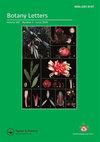The climbing flora of New Caledonia: a comprehensive checklist
IF 1.3
4区 生物学
Q3 PLANT SCIENCES
引用次数: 1
Abstract
ABSTRACT New Caledonia, an archipelago located in the southwest Pacific Ocean, hosts a rich and highly original vascular flora, distributed within a remarkable mosaic of habitats. Despite intensive research on the flora, the diversity and ecology of the climbing flora within the archipelago remain virtually unknown. More globally, while most liana studies have been carried out in continental forests, data from island ecosystems remain scarce. This study aims to document the taxonomic diversity, and to analyze the ecology and functional traits of angiosperms climbers in New Caledonia. Using herbarium data, exhaustive bibliographic review and field studies, we provide a checklist of 274 autochthonous climbing taxa, distributed in 45 families. The majority of climbing plant species in New Caledonia are woody, herbaceous vine being infrequent. Climbing plants account for ~ 8% of the native flora (angiosperms), a rather small contribution compared with continental tropical floras. There is, however, a great heterogeneity in the distribution of climbing plants within the different vegetation, as they represent up to 19% of species in the sclerophyll forests, and only ~ 8 and 6.5% in respectively shrublands (maquis) and rain forests, which are the most original ecosystems in New Caledonia. The endemicity is relatively low (64%) compared to the global flora (75% of endemism). Three endemic genera are exclusively climbers (Artia, Balgoya and Clematepistephium). The diversity of climbing plants is concentrated within few families: ~29% belonging to Apocynaceae and more than half of the species are included in just four families.新喀里多尼亚的攀缘植物群:综合清单
新喀里多尼亚是位于西南太平洋的一个群岛,拥有丰富而高度原始的维管植物群,分布在一个引人注目的栖息地中。尽管对植物群进行了深入的研究,但群岛内攀缘植物群的多样性和生态学仍然几乎未知。在全球范围内,虽然大多数藤本植物研究都是在大陆森林中进行的,但来自岛屿生态系统的数据仍然很少。本研究旨在记录新喀里多尼亚被子植物的分类多样性,并分析其生态学和功能性状。利用植物标本馆资料、详尽的文献回顾和实地考察,我们列出了分布在45科的274个本土攀援类群的清单。新喀里多尼亚的大多数攀援植物都是木质的,草本藤本植物很少。攀缘植物占本地植物区系(被子植物)的约8%,与大陆热带植物区系相比,这是一个相当小的贡献。然而,攀援植物在不同植被中的分布存在很大的异质性,在硬叶林中,攀援植物占物种总数的19%,而在作为新喀里多尼亚最原始的生态系统的灌丛和雨林中,攀援植物分别仅占物种总数的8%和6.5%。与全球植物区系(75%的特有率)相比,该地区的特有率相对较低(64%)。三个特有属是专门的攀援植物(Artia, Balgoya和铁线菊)。攀缘植物的多样性集中在少数科:约29%属于夹竹桃科,超过一半的物种仅包括在四个科中。
本文章由计算机程序翻译,如有差异,请以英文原文为准。
求助全文
约1分钟内获得全文
求助全文
来源期刊

Botany Letters
Agricultural and Biological Sciences-Plant Science
CiteScore
3.10
自引率
6.70%
发文量
54
期刊介绍:
Botany Letters is an international scientific journal, published by the French Botanical Society (Société botanique de France) in partnership with Taylor & Francis. Botany Letters replaces Acta Botanica Gallica, which was created in 1993, building on over a century of renowned publications by the Société botanique de France.
 求助内容:
求助内容: 应助结果提醒方式:
应助结果提醒方式:


